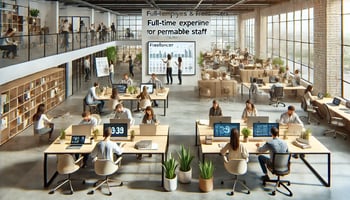As society progresses, each generation develops its own distinct identity, shaped by the cultural,...
Generational Differences in the Workplace: A Comparative Analysis from 1940 to Today
 As the modern workplace becomes increasingly diverse, the presence of multiple generations working side by side has brought about a fascinating dynamic. From the Silent Generation to Generation Z, each cohort brings its own set of values, work ethics, communication styles, and expectations. Understanding these differences is crucial for fostering a harmonious and productive work environment.
As the modern workplace becomes increasingly diverse, the presence of multiple generations working side by side has brought about a fascinating dynamic. From the Silent Generation to Generation Z, each cohort brings its own set of values, work ethics, communication styles, and expectations. Understanding these differences is crucial for fostering a harmonious and productive work environment.
The Silent Generation (Born 1928-1945): The Foundation of Workplace Loyalty
The Silent Generation, born between 1928 and 1945, laid the groundwork for the modern work ethic. This generation grew up during the Great Depression and World War II, experiences that instilled in them a strong sense of duty, loyalty, and respect for authority. In the workplace, they are often characterized by their dedication and commitment, often staying with a single employer for their entire career.
Workplace Values and Ethics:
- Loyalty and Stability: They value job security and are often resistant to change, preferring established routines and hierarchies.
- Respect for Authority: This generation tends to respect and adhere to the established chain of command, placing a high value on the experience and wisdom of their superiors.
- Work Ethic: They are known for their strong work ethic, often putting in long hours without complaint, viewing work as a duty rather than a source of personal fulfillment.
Challenges in Modern Workplaces: As this generation has largely retired, their approach to work can sometimes clash with the more fluid, dynamic work styles of younger generations. However, those still in the workforce are valued for their experience and reliability, often serving as mentors to younger colleagues.
Baby Boomers (Born 1946-1964): The Architects of Modern Work Culture
Baby Boomers, born in the post-World War II era, were instrumental in shaping the modern corporate culture. Coming of age during a period of unprecedented economic growth and social change, they entered the workforce with high aspirations and a strong belief in the American Dream.
Workplace Values and Ethics:
- Career Ambition: Boomers are often seen as the workaholics of the workforce, driven by a desire for success, status, and financial stability.
- Loyalty with a Twist: While they value loyalty, Boomers also seek recognition and advancement, leading many to change jobs if better opportunities arise.
- Face-to-Face Communication: They prefer direct, in-person communication, valuing meetings and discussions as vital to decision-making.
Challenges in Modern Workplaces: Boomers are now transitioning into retirement, but their presence is still felt. Their preference for traditional hierarchies and reluctance to adopt new technologies can sometimes lead to friction with younger, more tech-savvy employees. However, their deep institutional knowledge and experience make them invaluable assets in many organizations.
Generation X (Born 1965-1980): The Pragmatic Bridge
Generation X, often referred to as the "middle child" between Boomers and Millennials, is known for its independence, adaptability, and skepticism. Growing up during a time of economic instability and the rise of dual-income households, Gen Xers developed a pragmatic approach to work and life.
Workplace Values and Ethics:
- Work-Life Balance: Unlike their predecessors, Gen X values a healthy balance between work and personal life, often seeking flexible work arrangements.
- Independence and Resourcefulness: They are self-reliant and prefer to work independently, often questioning traditional processes and seeking more efficient solutions.
- Technological Adaptability: Gen X was the first generation to experience the digital revolution, making them adaptable to new technologies, though they still value some traditional methods.
Challenges in Modern Workplaces: As they move into leadership roles, Gen Xers are often caught between the established norms of the Boomers and the disruptive influence of Millennials. Their focus on efficiency and results can sometimes clash with the purpose-driven approach of younger employees, but their adaptability makes them effective leaders in a changing work environment.
Millennials (Born 1981-1996): The Purpose-Driven Innovators
Millennials, who began entering the workforce in the early 2000s, have been the subject of much discussion and debate. Known for their embrace of technology, desire for meaningful work, and tendency to job-hop, Millennials have redefined what it means to have a career.
Workplace Values and Ethics:
- Purpose Over Paycheck: Millennials are driven by a desire to find meaning in their work, often prioritizing job satisfaction and company culture over salary alone.
- Tech Savvy: As digital natives, they are comfortable with technology and expect workplaces to integrate the latest tools and platforms to enhance efficiency and collaboration.
- Collaboration and Feedback: They prefer a collaborative work environment with continuous feedback and opportunities for growth.
Challenges in Modern Workplaces: Millennials’ desire for constant feedback and rapid career progression can sometimes be at odds with the more measured approach of older generations. Their tendency to switch jobs frequently can also be seen as a lack of loyalty. However, their innovative thinking and comfort with technology make them invaluable in driving modern businesses forward.
Generation Z (Born 1997-2012): The Digital Natives
Generation Z, the newest entrants to the workforce, are already making their mark with their pragmatism, entrepreneurial spirit, and deep connection to digital technology. Having grown up with smartphones and social media, they are true digital natives.
Workplace Values and Ethics:
- Financial Stability: Shaped by the Great Recession and economic uncertainty, Gen Z places a high value on financial security and stability.
- Entrepreneurial Spirit: Many in this generation are drawn to entrepreneurship and side gigs, valuing independence and creative control over their careers.
- Digital Communication: Gen Z prefers quick, efficient communication, often relying on digital platforms for everything from collaboration to professional networking.
Challenges in Modern Workplaces: As the youngest generation in the workforce, Gen Z's emphasis on flexibility and immediate results can sometimes clash with the more traditional approaches of older generations. However, their tech-savvy nature and innovative thinking are critical assets in a rapidly evolving digital landscape.
Bridging the Generational Divide in the Workplace
With such diverse generational cohorts working together, the modern workplace is a melting pot of values, communication styles, and expectations. To create a cohesive and productive work environment, it’s essential to recognize and respect these differences while finding common ground.
-
Encourage Cross-Generational Mentorship: Leveraging the experience of older generations while embracing the fresh perspectives of younger employees can lead to a more innovative and dynamic workplace.
-
Foster Open Communication: Creating an environment where all employees feel heard and valued, regardless of their generation, is key to reducing misunderstandings and promoting collaboration.
-
Promote Flexibility: Offering flexible work arrangements and embracing new technologies can help accommodate the diverse needs and preferences of a multi-generational workforce.
-
Embrace Diversity and Inclusion: Recognizing the unique strengths and contributions of each generation can lead to a more inclusive and supportive work culture.
By understanding and appreciating the differences among generations, organizations can harness the strengths of each group, creating a more dynamic, innovative, and successful workplace. As the workforce continues to evolve, the ability to bridge the generational divide will be an increasingly important skill for businesses and leaders alike.



